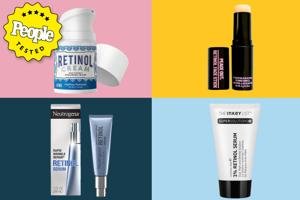Anti-aging serums with retinol have become a staple in many skincare routines. These powerful products can help reduce the signs of aging and improve skin texture.
Retinol serums can boost collagen production, fade dark spots, and smooth fine lines and wrinkles.
When choosing a retinol serum, it’s important to consider your skin type and concerns.
Many top-rated retinol serums are available for different needs, from acne-prone to mature skin.
We recommend starting with a lower concentration and gradually increasing as your skin adjusts.
Using retinol properly is key to seeing results.
Apply the serum at night, as sunlight can degrade its effectiveness.
It’s also crucial to use sunscreen during the day, as retinol can make skin more sensitive to UV rays.
Key Takeaways
- Retinol serums can improve skin texture and reduce signs of aging
- Choose a retinol product based on your skin type and concerns
- Use retinol at night and always apply sunscreen during the day
Understanding Retinol and Its Benefits
Retinol is a powerful anti-aging ingredient that can transform your skin. It works to reduce fine lines, fade dark spots, and improve skin texture.
The Science of Retinol and Skin Renewal
Retinol is a form of vitamin A that boosts cell turnover in the skin. When applied, it converts to retinoic acid, which can penetrate deep into the skin.
This process helps speed up the creation of new skin cells.
Retinol also boosts collagen and elastin production. These proteins give skin its firmness and bounce. As we age, our natural levels decrease, leading to wrinkles and sagging.
By using retinol, we can help reverse some signs of aging and sun damage. It can fade dark spots and hyperpigmentation by evening out skin tone.
Retinol Serums vs Other Retinoids
Retinol is part of a larger family called retinoids. Other types include tretinoin, adapalene, and retinaldehyde.
Retinol is generally milder than prescription retinoids.
Retinol serums are popular over-the-counter options. They’re often gentler on the skin compared to stronger retinoids.
This makes them a good choice for those new to vitamin A products.
Tretinoin is a stronger, prescription-only retinoid. It works faster but can cause more irritation. Adapalene is now available over-the-counter and is often used for acne.
Choosing the Right Retinol Strength
Retinol products come in different strengths, typically ranging from 0.01% to 1%. For beginners, it’s best to start with a low concentration and work your way up.
Here’s a simple guide:
- 0.01% to 0.03%: Ideal for sensitive skin or beginners
- 0.04% to 0.1%: Good for most skin types
- 0.5% to 1%: Best for experienced users or those with resilient skin
It’s important to start slowly when using retinol.
Begin with 2-3 times a week and gradually increase usage. This helps minimize potential side effects like redness or peeling.
Some products use encapsulated retinol or time-release formulas. These can be gentler on the skin while still being effective.
Best Practices for Using Retinol Serums
Retinol serums can be powerful anti-aging tools when used correctly. We’ll cover key strategies for incorporating retinol into your skincare routine, managing potential side effects, and pairing it with complementary ingredients.
Incorporating Retinol Into Your Skincare Routine
Start by using retinol serums 2-3 times a week at night. Cleanse your face and wait 20-30 minutes before applying a pea-sized amount.
Gradually increase frequency as your skin adjusts.
For your daily routine, apply sunscreen with at least SPF 30 every morning. This protects your skin from increased sun sensitivity caused by retinol.
At night, layer a moisturizer over your retinol serum to boost hydration. Look for products with hyaluronic acid, glycerin, or ceramides.
If you have sensitive skin, try the “sandwich method”: Apply moisturizer, then retinol, then moisturizer again.
Mitigating Retinol Side Effects
Retinol can cause dryness, redness, and peeling. To minimize these effects:
- Start with a low concentration (0.01-0.03%) and increase slowly
- Use retinol every 2-3 nights at first, then gradually increase frequency
- Apply a fragrance-free moisturizer before and after retinol
- Take breaks if irritation occurs
For dry or sensitive skin, mix retinol with moisturizer or use it every 3rd night.
Oily or acne-prone skin may tolerate retinol better. Still, start slow and increase as tolerated.
Complementary Ingredients and Products
Pair retinol with hydrating ingredients like:
- Hyaluronic acid
- Glycerin
- Ceramides
- Niacinamide
- Peptides
These help counter dryness and support skin barrier function.
Avoid using retinol with:
- Vitamin C (use vitamin C in the morning, retinol at night)
- AHAs/BHAs (can increase irritation)
- Benzoyl peroxide (can deactivate retinol)
Antioxidants like vitamin E can enhance retinol’s effects. Use a vitamin E serum in the morning.
For very sensitive skin, try gentler alternatives like bakuchiol or centella asiatica.
Frequently Asked Questions
Retinol serums offer powerful anti-aging benefits but require careful use. We’ll address common questions about their effectiveness, usage, and potential side effects.
What are the benefits of using an anti-aging serum with retinol?
Retinol serums can reduce fine lines and wrinkles. They boost collagen production and speed up cell turnover.
These serums also help even out skin tone and fade dark spots. Many users notice smoother, firmer skin with regular use.
How can I incorporate retinol serums into my skincare routine for anti-aging purposes?
We recommend starting with a low concentration 2-3 times per week. Apply a pea-sized amount to clean, dry skin at night.
Gradually increase frequency as your skin adjusts. Always follow with a moisturizer and use sunscreen during the day.
What concentration of retinol is effective in anti-aging serums?
For beginners, 0.01% to 0.03% retinol is a good starting point. More experienced users can try 0.3% to 1% concentrations.
Higher percentages may be more effective but can also cause more irritation. It’s best to consult a dermatologist for personalized advice.
Are there any side effects associated with using anti-aging retinol serums?
Some people experience redness, dryness, or peeling when starting retinol. These effects usually subside as skin adjusts.
To minimize irritation, start with a low concentration and use it less frequently. Always moisturize and protect your skin from sun exposure.
Can I use a retinol serum in conjunction with other anti-aging ingredients like hyaluronic acid?
Yes, retinol can be used with other anti-aging ingredients. Hyaluronic acid can help combat dryness often associated with retinol use.
We suggest applying hyaluronic acid first, then retinol. Wait a few minutes between each product to allow absorption.
What are some dermatologist-recommended anti-aging serums containing retinol?
Dermatologists often recommend SkinCeuticals Retinol 0.3 for its effective formula. It’s suitable for most skin types.
Another top pick is Skinbetter Science AlphaRet, which combines retinol with lactic acid for enhanced results.
For a budget-friendly option, L’Oréal Triple Power Anti-Aging Moisturizer is highly rated. It’s non-sticky and fragrance-free.
Statistic Table
We’ve compiled some key statistics about retinol serums to help you understand their popularity and effectiveness. Here’s a quick overview:
| Statistic | Value |
|---|---|
| Percentage of dermatologists recommending retinol | 88% |
| Average age people start using retinol | 25-30 years |
| Typical retinol concentration in over-the-counter products | 0.01% – 1% |
| Time to see visible results | 4-12 weeks |
| Percentage of users reporting improved skin texture | 75% |
Retinol serums have gained significant traction in the skincare market. Many brands now offer retinol-based products, catering to different skin types and concerns.
It’s worth noting that retinol strength can vary widely between products. Some advanced formulas may contain up to 2% retinol, but these are less common and often require a prescription.
We found that consistent use is key to seeing results. Most users report improvements in fine lines, skin texture, and overall complexion when using retinol serums regularly for several months.



